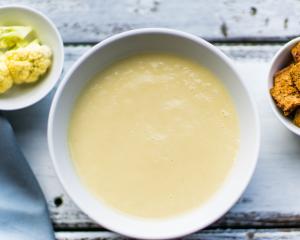
He believes this thinking will only continue to result in the widespread depletion of oceans so in Take One Fish he hopes to open people’s eyes to the potential of just one fish in the kitchen.

Storage Essentials
1. Chuck the ice: When you buy your fish, request that it is not directly surrounded by ice. Ask for the ice to be supplied separately or, alternatively, bring along an ice pack in a cooler bag for transportation.
2. Wrap it in paper: Request the fish be wrapped in paper, not plastic. Fish that is stored in plastic at variable temperatures will start perspiring, become damp and develop ammonia aromas (aka fishy fish).
3. Take it out of the packaging: Once home, remove the fish from its packaging. If your fish is already scaled and gutted and you are cooking it that day, then transfer it to a clean wire rack set over a small tray or dinner plate and place it in the main chamber of your fridge, uncovered, until ready to use.
A minimum of 2 hours in the fridge like this will result in a skin that is dry enough to achieve crisp skin when pan-frying and give you confidence that it will not stick to your grill bars or pan (your fridge will only smell fishy if you are buying poor-quality fish).
If you are buying a fish for 2-3 days’ time, still place it on the wire rack but instead of putting it in the central part of the fridge, clear out the crisper at the base and store it there with the humidity vents left open. This will allow the fish to sit at a slightly lower temperature and not dry out too far, as we want to maintain day-one excellence but remove some of the fish’s unnecessary moisture. On the day you remove it from the crisper, ready to cook, put it in the main part of the fridge for 1 hour to dry the skin before cooking.
4. Leave the skin on: Regardless of whether you are pan-frying to make the skin crisp or poaching with the intent to discard the skin, it will benefit the fish’s overall flavour profile and nutritional value if you leave the skin on. The seam of fat that sits beneath the skin provides much of a fish’s wonderful flavour and is also a rich source of omega 3s.
5. Do not wash a fishy fish: Washing a fish will not remove the smell of ammonia. If anything, it will make the fish more challenging to cook and add to the issue. The only way to partially eliminate or dilute volatile aromas such as ammonia is through the use of acidity. Lemon juice or tomato-based cookery methods, along with garlic and other alliums all help mask odours (one reason that they are used so often in fish cookery), but the best approach is to shop wisely to avoid this situation in the first place.
6. Keep it on the bone: When working with a whole fish, keep it on the bone right up until you decide what to do with it. Leaving the fish on the bone reduces the potential for the flesh to be exposed to external moisture or bacteria growth.
7. Hang for longer-term storage: If you want to store fish beyond its first few days, use a static fridge with no fan. Here fish can be stored on perforated trays but, ideally, they will be hung from the tail on hooks in a whole form post-scaling and gutting. To maintain these fish over a period of time, wipe the skin and cavity of the fish with paper towel to remove the perspiration that naturally comes to the surface.
8. Look after leftovers: For leftover cooked fish, ensure it is completely cold and then store in a clean, dry, covered container (ideally with a ventilated lid) in the fridge for up to 2 days, making sure that the temperature is well maintained. If reheating to serve, do so thoroughly.
Tips When Buying Your Fish
1. Have a game plan: Know how many you are feeding and what methods of cookery you have available to you before you go to the fish shop.
2. Know what to look for (whole fish): Glistening eyes that are bulbous and clear, a firmness in appearance and to the touch, scales that are tightly composed and are unaffected by bruising, abrasions or deep cuts, and a light ocean or seaweed odour.
3. Know what to look for (fillets): Ensure that the fillets are dry and not sitting in a puddle of their juices, ice and water, that the skin is intact, free from bruising and marking, and that the flesh is translucent and glassy (it should not appear to be foggy, milky or have a brown lateral muscle, as these are all key indicators of a poorly handled fish).
4. Know what to look for (frozen): All of the above quality points are relevant, but also be certain to check packaging dates and inspect quality of freezing to make sure there is no freezer burn (telltale signs of which include ice crystals on the fish itself and discolouration in spots).
5. Ask questions: Speak to the attendant about what has just arrived, or what they would personally buy.
6. Get the work done for you: If you would like a fish to be filleted, de-boned, butterflied or have its skin removed, then ask for it! There is nothing wrong with getting a professional to do this for you, especially if it will improve your experience with the fish once you get home.
7. Look past the top tier: You don't always need to buy the centre cut of a fillet or pay top dollar for the most premium fish available. Instead, if a recipe calls for fish mince, or just the collars or even the tail of the fish, be specific and ask for these items. It would be ludicrously expensive to mince beef fillet or sirloin for a lasagne, not to mention it being the wrong cut to be cooking for hours. Fish have muscles and components to them that offer different flavours, textures and, importantly, come in at different price points. In short, start thinking about buying fish like you would meat.
8. Demand diversity: If you are looking for a fish that doesn't appear to be available, then ask for it! This will give the fish shop the confidence they might need to go out and buy more than the four species of heavily trafficked fish that they currently stock.
9. Ask about cooking: While you are shopping, ask about cookery methods that are applicable to the fish you have chosen. You might pick up some good advice that will lead not only to a delicious dinner but also a greater confidence moving forward.
10. Be loyal but not submissive: It is important to buy fish from responsible fish-shop owners whose products are ethically sourced; however, if you buy a fish and have a negative experience then be sure to give feedback. Don't settle for fishy fish or a fish that is mushy or tough.

Drunken bass groper, mushrooms and condiments
This dish is inspired by two incredible Australian chefs, Kylie Kwong and Neil Perry. I have had many memorable experiences with a dish of this nature at both of their restaurants. The big, fleshy, succulent bass groper (known as Hapuku in New Zealand) really comes into its own here as it soaks up the flavours from the stock. And while this dish is designed to be eaten hot on the day you cook it, another option is to make it a day ahead and store the fish in the stock overnight, then serve it cold the next day.
Depending on the particular fish, the gelatine from the skin and bones can set the stock into a jelly, which is so delicious. The stock itself may be used in other ways; its brilliant for cooking mushrooms, chicken, pork and vegetables of all kinds. Similarly, the ginger spring onion sauce also translates very well to a number of other recipes.
Serves 4
4 x 150 g bass groper darnes, skin on
12 fresh shiitake mushrooms
100g oyster mushrooms
100g enoki mushrooms
1 tsp sesame oil
XO sauce, to serve
Ginger spring onion sauce
50g (finely grated fresh ginger (older ginger will be spicier)
6 spring onions , finely sliced
350ml peanut oil (or canola oil)
60-70ml light soy sauce, to taste
White pepper, sesame and sichuan seasoning
1 Tbsp ground white pepper
1 Tbsp white sesame seeds
1 Tbsp sichuan peppercorns
Stock
2.5 litres (10 cups) shaoxing rice wine
175ml light soy sauce
75g (23) dried shiitake mushrooms
225g peeled fresh ginger, cut into 23 mm thick slices
7 spring onions (scallions), cut into 5 cm batons
2 Tbsp ground white pepper
4 star anise
2 garlic bulbs, halved
8.5 litres (34 cups) water
Method
To make the ginger spring onion sauce, combine the ginger and spring onion in a small heatproof bowl. Heat the oil in a small saucepan until almost smoking, then immediately pour it over the ginger and spring onion mixture. You should see and hear it sizzling. (If this isn’t happening the oil isn’t hot enough, so return it to the heat and try again.)
Season with the soy and mix together well.
Set aside to cool to room temperature. The sauce will keep in the fridge for up to a week, but the flavour will start to lose its punch over time.
For the white pepper, sesame and sichuan seasoning, toast the ingredients individually in a dry frying pan until aromatic, then use a mortar and pestle to grind them together into a powder.
Spoon into a small bowl and set aside.
Add all the stock ingredients to a large saucepan and bring to the boil over a high heat, then reduce the heat and simmer for 1 hour.
Remove from the heat. Add the groper chops, cover with a lid and set aside for 10-12 minutes, until the flesh is just opaque and the internal temperature of the fish at its thickest part measures 44degC on a probe thermometer.
Using a slotted spoon, carefully transfer the fish pieces to a clean plate and gently peel away the skin (it should peel off easily if the flesh is cooked).
Leave to rest for 3-4 minutes.
While the fish is resting, add the mushrooms to the hot stock (still off the heat) and leave for 2 minutes to gently warm through.
Divide the fish pieces among serving bowls, top with the tender mushrooms, drizzle over a little sesame oil and ladle over a little of the stock to finish.
Serve immediately with the ginger spring onion sauce, sichuan seasoning and a small bowl of XO sauce.
Note: This stock can be used over and over again, and will become increasingly flavourful and viscous every time you use it. To store it safely, bring the stock to the boil after every use, then strain off any impurities and keep in an airtight container in the fridge. If you find the flavour becomes unbalanced from reduction, just add some water; similarly, if it needs a boost, add soy sauce, shaoxing rice wine or fresh aromats to restore the flavour profile.

Red gurnard, seaweed, dauphine potato pie
Everything old is new again. I first made this dauphine potato recipe as an apprentice chef; the mashed potato was mixed with choux pastry then spooned into the deep-fryer and cooked until crisp and fluffy. All these years later, I decided it would make the perfect topping for my gurnard and seaweed pie. Red gurnard is the ideal fish for a bechamel-based pie like this. Its firm texture, sweetness and rich shellfish characteristics shine through, even beneath the golden potato topping. The seaweed brings a level of complexity and savouriness to the pie that spinach or other green vegetables just can’t, so take the time to source the best quality you can find.
Serves 4-6
500ml (2 cups) full-cream (whole) milk
2 Tbsp white miso paste
10cm piece of kombu
10g bonito flakes
50g butter
50g (1/3 cup) plain (all-purpose) flour
20g dried wakame seaweed, softened in cold water
sea salt flakes and freshly cracked
black pepper
800g boneless red gurnard fillet, skin on, cut into 3cm chunks
Dauphine potato
1kg whole royal blue or Dutch cream potatoes
rock salt, for cooking
50g butter
100ml water
pinch of sea salt flakes
100g (2/3 cup) plain (all-purpose) flour
3 eggs, lightly beaten
½ tsp baking powder
freshly grated nutmeg, to taste
freshly cracked black pepper
1 egg, extra, plus 1 egg yolk, lightly beaten to make an egg wash
Method:
Whisk the milk, miso, kombu and bonito flakes in a saucepan over a medium heat. Bring the mix up to approximately 85degC and hold over a low heat to keep warm for about 20 minutes.
In a separate saucepan, melt the butter over a medium heat. Add the flour and cook for 2 minutes or so, stirring with a wooden spoon to form a roux. Remove the strip of kombu from the hot milk and strain off the bonito flakes, then gradually add the strained milk to the roux, one-third at a time, whisking after each addition to create a smooth sauce. When you have incorporated all the milk, bring the sauce to the boil and add the softened wakame. Season to taste, then remove from the heat and closely cover the sauce with plastic wrap
or baking paper to stop a skin forming. Refrigerate until completely cold.
Add the gurnard chunks to the chilled bechamel and combine well, then spoon the filling into a 2.5-litre (10-cup) baking dish or two smaller baking dishes suitable for a pie. Preheat the oven to 190degC.
For the dauphine potato, place the washed potatoes on a baking tray covered with a generous layer of rock salt and bake for 1 hour, or until tender when pierced with a skewer or sharp knife. Remove the potatoes from the tray one at a time, then, while hot, scoop out the flesh into a wide-based saucepan. Mash and then stir over a low heat for 1-2 minutes to steam off any excess moisture.
Increase the oven temperature to 200degC.
Place the butter, water and salt in a large saucepan over a low heat until the butter has melted. Increase the heat to medium-high and bring to the boil, then remove from the heat and beat in the flour until well combined. Set the pan back over a medium heat and beat for a further 2-3 minutes until the mixture comes together and starts to leave the side of the pan. Transfer to a stand mixer fitted with the paddle attachment and beat for 1-2 minutes until the dough is no longer hot but still warm. Add the egg a little at a time, checking the texture of the mixture as you go until it reaches dropping consistency (that is, it should fall very slowly from a spoon when held over the bowl). You may not need all the egg to reach this point.
Combine the dauphine base with 500g of the warm mashed potato, stir in the baking powder and nutmeg and season liberally with salt flakes and pepper. Scoop the mash into a piping bag and pipe evenly over the filling. Brush the surface lightly with the egg wash, then drag a fork from one end of the pie to the other to create indentations in the potato.
Bake for 35 minutes, or until the dauphine potato is crisp and golden. Finish with a sprinkling of salt flakes, then rest the pie for 5 minutes before serving.

Flounder and other flat fish are strange things. When a flounder is born it is bilaterally symmetrical, with an eye on each side, and swims near the surface of the sea, but after a few days it begins to lean over to one side, and the eye on the other begins to migrate to what eventually becomes the top side of the fish. With this development a number of other changes in bones, nerves and muscles occur, and the underside of the flounder loses its colour.
As a table fish, flounder are revered for this unique skeletal makeup, which carries no pin bones, together with four fillets that can be simply removed from the one central frame. When I see a flounder, I like to think about how best I can both harness the gelatine it contains and showcase its firm fillets.
Often the answer is by applying direct heat from a wood burning or charcoal burning grill, enriching the flesh and skin with a deep savouriness achieved by smoke and seasoning. Flavours such as chilli, butter, capers, mushrooms, vinegar, seaweed, mussels and anchovy all get me really excited to cook with flounder, but the key is getting that method of cookery correct and pairing the fish with the right amount of seasoning to knock it out of the park.
Serves 4
2 x 500g whole greenback flounder, gutted and scaled
60ml (¼ cup) grapeseed oil
sea salt flakes
4 soft white floury bread rolls, warmed cold butter, for spreading
Flounder gravy, to serve (optional)
Fries, to serve (optional)
Flounder seasoning
2 Tbsp freshly ground fennel seeds
2 Tbsp freshly ground black peppercorns
2 tsp freshly ground cumin seeds
2 tsp freshly ground coriander seeds
1 tsp onion powder
1 tsp garlic powder
1 tsp ground turmeric
1 tsp cayenne pepper
Celeriac coleslaw
¼ red cabbage, finely shredded
1 large celeriac, finely sliced
2 carrots, finely sliced
300g quality mayonnaise
60ml ( ¼ cup) chardonnay vinegar
sea salt flakes and freshly cracked
black pepper
1 tsp toasted celery seeds
Method
For the flounder seasoning, combine all the spices in an airtight container and set aside until needed. It will keep in the pantry for up to 1 month.
To make the celeriac coleslaw, place the cabbage, celeriac and carrot in a large bowl. Whisk together the mayonnaise, vinegar, salt, pepper and celery seeds in a small bowl. Pour about half of the dressing over the salad and toss to combine. Slowly add more dressing until you’ve reached your desired ratio of coleslaw to dressing. Set aside.
Prepare a charcoal grill, making sure the grill is hot and the charcoal has cooked down to hot embers. Level out the embers so the heat is even.
Using scissors, snip off any fins around the skirt of the flounder, as these will be the first things to scorch and become tatty during cooking. Brush the fish on both sides with a little grapeseed oil and season well with salt flakes and the flounder seasoning (about 2 teaspoons for each fish).
Place the flounder directly on the grill racks, dark (top) side down, and grill for 4 minutes each side, or until the internal temperature on the bone of the flounder reaches 48degC on a probe thermometer.
Transfer the fish to a large serving platter and leave to rest for 5 minutes. Serve with the coleslaw, warm bread rolls, cold butter, gravy and a generous mound of fries, if you like.
Flounder gravy (makes 1 cup)
Like most of the brown fish stock-based sauces in this book, this one takes the bones of a single species of fish (in this case, the flounder) and roasts them until they are very well caramelised. This step is critical as it lays strong foundations for the sauce. Too much colour will result in a bitter outcome, and not enough will see an insipid, watery gravy. The dark soy and Vegemite round out the sauce, adding deep umami characteristics that can be challenging to extract from fish (as opposed to meat) bones. To check the viscosity of the reduced sauce, spoon it onto a cool dinner plate to see exactly how thick it is when it cools. This is also a good opportunity to taste it. I realise the abundance of ingredients doesn’t give a significant yield, but look at it as the icing on a cake in terms of making a meal complete.
Ingredients (gravy)
100g ghee
2 kg flounder frames, gills and guts removed
6 large brown onions, finely sliced
6 garlic cloves, sliced
1 fresh bay leaf
15 thyme sprigs
300 ml white wine
2 ½ Tbsp sherry vinegar
1 tsp Vegemite
1 tsp dark soy sauce
750 ml (3 cups) Brown Fish Stock
sea salt flakes and freshly cracked black pepper
Method (gravy)
Heat the ghee in a large heavy-based saucepan over a medium heat to a light haze, add the flounder bones and caramelise for 10 minutes until well browned. Add the onion, garlic, bay leaf and thyme and stir to combine. Cook, covered, for 10 minutes, or until the onion is soft and translucent. Remove the lid and cook for a further 10 minutes until the onion is caramelised, then deglaze the pan with the wine and vinegar and simmer until reduced to a syrup. Stir in the Vegemite and dark soy, followed by the fish stock, then bring to a simmer and cook for 20 minutes, or until reduced by half. Season well with salt and pepper.
Transfer everything to a food processor and blitz to a thickish, coarse sauce (do this in batches if necessary). Pass this liquid through a fine sieve, discarding the solids, then taste and adjust the seasoning. At this point the sauce may need further reducing (see recipe intro); if so, return to a medium heat and simmer for further 5 minutes or until the gravy is thick enough to lightly coat the back of a spoon. It is now ready to serve.
Store the stock in an airtight container in the fridge for up to a week, or in the freezer for up to a month.












